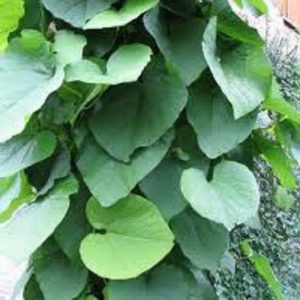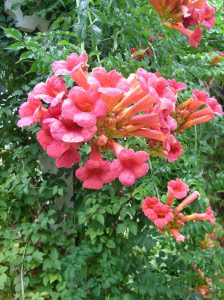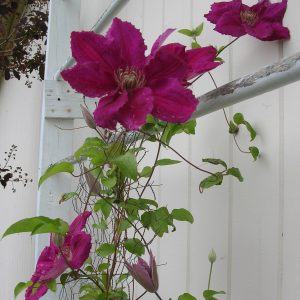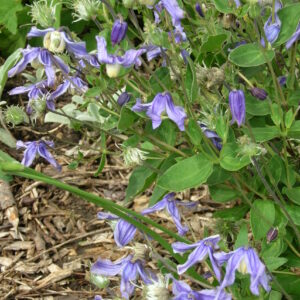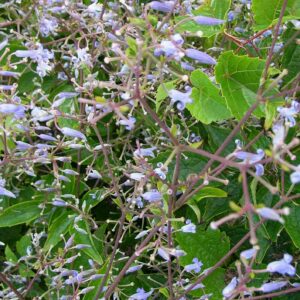Vines
Showing 1–8 of 15 results
-
Aristolochia durior syn. A. macrophylla, A sipho Dutchman’s pipe, Birthwort Z 4-8
Yellow, mottled brown flowers like Meerschaum pipes in May – June, mostly grown for heart-shaped leaves on this vigorous climber (climbs by twining). Perfect for creating a screen on pergolas, arbors and fences.
OUT OF STOCK
Yellow, mottled brown flowers like Meerschaum pipes in May – June, mostly grown for heart-shaped leaves on this vigorous climber (climbs by twining). Perfect for creating a screen on pergolas, arbors and fences.
Size: 20-30’ x 2’ at ground, 20’ on top.
Care: sun to shade (one of few vines for shade) in moist well-drained to moist soil. Prune to encourage branching.
Native: Maine to Georgia, west to KS.
Wildlife Value: host Pipevine swallowtail butterflyAristolochia is Greek for easing childbirth. Cherokee applied decoction of root for swollen legs & feet. Collected by Colonial nurseryman John Bartram and sent to England in 1763. Sold in America’s 1st plant catalog, Bartram’s Broadside, 1783. In Colonial and Victorian gardens, popular vine to create privacy and shade
-
Campsis radicans Trumpet vine Z 5-9
Huge, gorgeous orange trumpets on vigorous vine
OUT OF STOCK
Mid summer into autumn – huge, gorgeous orange trumpets on vigorous vine
Size: 30’ x 3’ at base
Care: sun moist well-drained soil
Native: PA to IL & south as far as Florida
Wildlife Value: Hummingbird magnet.In garden cultivation in America since 1600’s. Collected in 1640’s by English gardener Tradescant the Younger. John Bartram grew it in his Philadelphia nursery nearly 300 years ago. Campsis is derived from the Greek word kampsis referring to the flower’s curved stamens. Radicans from radicant meaning “having rooted stems.” The bloom is “a most splendid sight,” according to Breck in 1851. Per Liberty Hyde Bailey in 1912: “The native trumpet creeper is very common in the southern woodlands and fields (with) a great variety in brilliancy of the blossoms. This is an excellent plant for covering the bare trunks of palmettos.” Pressed specimen in Emily Dickinson’s herbarium.
-
Clematis ‘Madame Julia Correvon,’ Z 4-9
Rich-red petal-like tepals 3-4” across bloom from June to September, encircling yellow stamens, on this vigorous, climbing vine
OUT OF STOCK
Rich-red petal-like tepals 3-4” across bloom from June to September, encircling yellow stamens, on this vigorous, climbing vine
Size: 12’ x 3-6’
Care: Sun to part shade in moist, well-drained soil. Cut back in early spring about 1’ above the soil level and just above a a pair of buds.
Wildlife Value: deer and rabbit resistant. Walnut tolerant. Attracts bees and butterflies.
Awards: Royal Horticultural Society Award of Garden MeritFrancisque Morel, Clematis breeder in Lyon France, grew this Clematis in 1900 from a cross of Clematis viticella ‘Rubra grandiflora’ and Clematis ‘Ville de Lyon,’ Named for the wife of the award-winning Geneva Switzerland nurseryman and author specializing in alpine plants, Henri Correvon (1855-1935). Nurseries at at 2 Chemin Dancet, 2 Plainpalais and Chêne-Bourg. Obituary https://www.nature.com/articles/144183b0.
-
Clematis ‘Ernest Markham’ Z 4-10
Big, bright magenta blooms June & repeat August – September, vigorous.
OUT OF STOCK
Big, bright magenta blooms June & repeat August – September, vigorous.
Size: 10-12’ x 2-3'
Care: Sun to part shade. Blooms on both old & new stems so cut back in early spring above healthy, big buds about 1' above ground.
Awards: Rated good by Chicago Botanical Garden Clematis evaluation.Hybrid c. 1930 by Ernest Markham (1881-1937) of England, head gardener at Gravetye Manor, home of William Robinson, father of mixed perennial borders.
-
Clematis integrifolia Z 3-7
Summer, real true blue and sometimes white, pendant flowers measuring 2" across on this short, non-vining Clematis
OUT OF STOCK
Summer, beautiful true blue and sometimes white, pendant flowers measuring 2” across on this short, non-vining Clematis
Size: 24" x 24"
Care: Sun to part shade in humusy, well-drained soil. Prune to near ground in early spring.
Native: Central EuropeThe genus Clematis was named by Dioscordes, physician in Nero’s army, from “klema” meaning climbing plant. Sixteenth century English herbalist John Gerard called Clematis “traveler’s joy” because of the joy given to travelers by the beauty of the flowers. This species collected in Hungary by 1573. English herbalist Gerard grew this plant by the late 1590’s.
-
Clematis occidentalis var. occidentalis Purple clematis. Short-styled bluebell Z 4-8
Four petaled (sepals), purple, down-facing, 4” long bells flowering in spring encircling a bundle of styles and stamens.
OUT OF STOCK – EMAIL FOR AVAILABILITY
Four petaled (sepals), purple, down-facing, 4” long bells flowering in spring encircling a bundle of styles and stamens.
Size: 3-12” x 2’
Care: sun to shade in moist well-drained to well-drained, alkaline soil
Native: Maine to Minnesota south to Illinois and South Carolina and all states between, Wisconsin native. Endangered in three states; “of special concern” in Wisconsin and gone in Ohio.The species first described by Danish botanist Jens Wilken Hornemann in 1805. var. occidentalis is the eastern variety of the species (peculiarly called occidentalis meaning west.) The species and other varieties are native in western US.
-
Clematis stans Japanese clematis Z 4-8
soulful blue starry nodding bells
OUT OF STOCK
Fragrant, smelling of sweet violets, soulful blue starry nodding bells with petals that flip up at the ends (recurved) Blooms August – September. Ships only in spring
Size: 30" x 24"
Care: sun to part shade in moist well-drained soil
Native: JapanStans means “upright” as this is a bush, rather than a vine. (OK, we’ve put this in the vine category and it’s not a vine. But most people think of Clematis as vines and we didn’t want you to miss it.) In Japan called “Kusa-botan.” Collected by Ernest Henry ‘Chinese’ Wilson before 1910.
-
Clematis tangutica Russian virgin bower Z 4-9
Small yellow flowers bloom for months
Small yellow flowers bloom for months, from July to September, then turn into ornamental spidery seed heads.
Size: 15-20’ x 6-10’
Care: Sun - part shade in moist well-drained to well-drained soil. Prune close to the ground in spring.
Native: NW China and TurkestanThe genus Clematis was named by Dioscordes, physician in Nero’s army, from klema meaning “climbing plant.” Sixteenth century English herbalist John Gerard called Clematis “traveler’s joy” because of the joy given to travelers by the beauty of the flowers. This species, C. tangutica introduced to western cultivation in 1898 when it was sent to Kew Gardens from St. Petersburg, Russia, after its discovery in Tibet.
**LISTED AS OUT OF STOCK BECAUSE WE DO NOT SHIP THIS ITEM. IT IS AVAILABLE FOR PURCHASE AT OUR RETAIL LOCATION.

